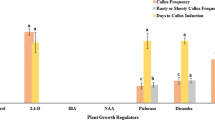Abstract
Interactive effects of genotypes with callus induction and regeneration media combinations on green plantlet regeneration response were studied for three indica rice (Oryza sativa L.) cultivars, IR-72, IR-54 and Karnal Local. Isolated mature-embryos were used to derive scutellar callus and fifteen media combinations involving MS, N6, R2, SK1 and some modifications were tested. Regeneration percentage as well as the shoot-bud induction frequency were influenced by genotype, callus induction medium, regeneration medium, interaction between genotype and the two media (callus induction and regeneration) as well the interaction between the callus induction medium and regeneration medium. Basal media combination of SK1m (callusing) and MS (regeneration) was found to be the best for cv. Karnal Local in which regeneration frequency of 88% and shoot-bud induction of 233% was observed. In IR-72, the highest regeneration frequency of 47.5% and shoot-bud induction frequency of 77% was obtained on MS-MS combination. In IR-54, highest regeneration frequency (25%) was recorded on MMS(N)-MMS(N) combination, whereas, highest frequency of shoot-bud induction (50%) was observed on MMS(S)-MS combination. Although genotype and the composition of the callus induction basal medium were the major determinants of regeneration response, an overall analysis of variation also revealed a significant interaction between the media used for de-differentiation (callusing) and re-differentiation (plantlet regeneration).
Similar content being viewed by others
References
Abe T & Futsuhara Y (1986) Genotypic variability for callus formation and plant regeneration in rice (Oryza sativaL.). Theor. Appl.Genet. 72: 3-10
Agache S, De Buyser J, Henry J & Snape JW (1988) Studies of the genetic relationship between anther culture and somatic tissue culture abilities in wheat. Plant Breeding 100: 26-33
Bajaj S & Rajam MV (1995) Efficient plant regeneration from long-term callus cultures of rice by spermidine. Plant Cell Rep. 14: 717-720
Biswas GCG & Zapata FJ (1993) High frequency plant regeneration from protoplasts of indica rice (Oryza sativaL.) using maltose. J. Plant Physiol. 141: 470-475
Chu CC, Wang CC, Sun CS, Hsu C, Yin KC, Chu CY & Bi FY (1975) Establishment of an efficient medium for anther culture of rice through comparative experiments on nitrogen source. Scientia Sinica 5: 659-668
Croughan TP & Chu QR (1991) In: Bajaj YPS (ed). Rice (Oryza sativaL.): Establishment of callus cultures and the regeneration of plants. In: Biotechnology in Agriculture and Forestry, Vol 14: (pp 19-37). Springer Verlag, Berlin.
Datta K, Potrykus I & Datta SK (1992) Efficient fertile plant regeneration from protoplasts of the indica rice breeding line IR-72 (Oryza sativaL.) Plant Cell Rep. 11: 229-233
Gamborg OL, Miller RA & Ojima K (1968) Nutrient requirements of suspension cultures of soyabean root cells. Exp. Cell Res. 50: 151-158
Hartke S & Lorz H (1989) Somatic embryogenesis and plant regeneration from various indica rice (Oryza sativaL.) genotypes. J. Genet.Breed. 43: 205-214
Khanna HK & Raina SK (1997) Enhanced plant regenerations in basmati rice (Oryza sativaL. cv Karnal Local) embryocalli through modifications of NO3 −+ NH4 +concentrations. Biochem. Biotech. 6: 75-80
Koetje DS, Grimes HD, Wang YC & Hodges TK (1989) Regeneration of indica rice (Oryza sativaL.) From primary callus derived from immature embryos. J. Plant Physiol. 135: 184-190
Lai KL & Liu 1F (1982) Induction and plant regeneration of callus from immature embryos of rice plants (Oryza sativaL.) Japan. Crop Sci. 51: 70-74
Lentini Z, Reyes P, Martinez CP & Roca W (1995) Androgenesis of highly recalcitrant rice genotypes with maltose and silver nitrate. Plant Sci. 110: 127-138
Luhrs R & Lorz H (1987) Plant regeneration in vitrofrom embryogenic cultures of spring-and winter-type barley (Hordeum vulgareL.) varieties. Theor. Appl. Genet. 75: 16-25
Mikami T & Kinoshita T (1988) Genotypic effects on the callus formation from different explants of rice, Oryza sativaL. Plant Cell Tiss. Org. Cult. 12: 311-314
Muller AJ & Grafe R (1978) Isolation and characterisation of cell lines of Nicotiana tabacumlacking nitrate reductase. Mol. Gen. Genet. 161: 67-76
Murashige T & Skoog F (1962) A revised medium for rapid growth and bioassays with tobacco tissue cultures. Physiol. Plant. 15: 473-497
Nlishi T, Yamada Y & Takashasi E (1968) Organ differentiation and plant restoration in rice callus. Nature 219: 508-509
Ohira K, Ojima K & Fujiwara A (1973) Studies on the nutrition of rice cell cultures I. A simple defined medium for rapid growth in suspension culture. Plant Cell Physiol. 14: 1113-1121
Peng J & Hodges T K (1989) Genetic analysis of plant regeneration in rice (Oryza sativaL.). In vitro: Cellular Devel Biol. 25: 91-94
Rakoczy-Trojanowska M & Malepszy S (1993) Genetic factor influencing the regeneration ability of rye (Secale cerealeL.). I. Immature inflorescences. Theor. Appl. Genet. 86: 406-410
Rakoczy-Trojanowska M & Malepszy S (1995) Genetic factors influencing the regeneration ability of rye (Secale cerealeL.). II. Immature embryos. Euphytica 83: 233-239
Raina SK (1989) Tissue culture in rice improvement: Status and potential. Adv. Agron. 42: 339-398
Raina SK (1997) Doubled haploid breeding in cereals. Plant Breed. Revs. 15: 141-186
Raina SK, Balachandaran SM, Virmani SS & Zapata FJ (1989) An improved medium for higher anther culture efficiency of certain high heterotic indica F1 hybrids. Int. Rice Res. News. 14: 4
Raina SK, Sathish P & Sarma K S (1987) Plant regeneration from in vitrocultures of anthers and mature seeds of rice (Oryza sativaL.) cv. Basmati-370. Plant Cell Rep. 6(6): 43-46
Rance IM, Tian W, Mathews H, Kochko A & Beachy R N (1994) Partial desiccation of mature embryo-derived calli, a simple treatment that dramatically enhances the regeneration ability of indica rice. Plant Cell Rep. 13: 647-651
Siriwardana S & Nobors MW (1983) Tryptophan enhancement of somatic embryogenesis in rice. Plant Physiol. 73: 142-146
Trewawas AJ & Cleland R E (1983) Is plant development regulated by changes in the concentration of growth substances or by changes in the sensitivity to growth substances? Trends in Biochem. Sci. 8: 354-357
Author information
Authors and Affiliations
Rights and permissions
About this article
Cite this article
Khanna, H.K., Raina, S.K. Genotype x culture media interaction effects on regeneration response of three indica rice cultivars. Plant Cell, Tissue and Organ Culture 52, 145–153 (1998). https://doi.org/10.1023/A:1006032303195
Issue Date:
DOI: https://doi.org/10.1023/A:1006032303195




